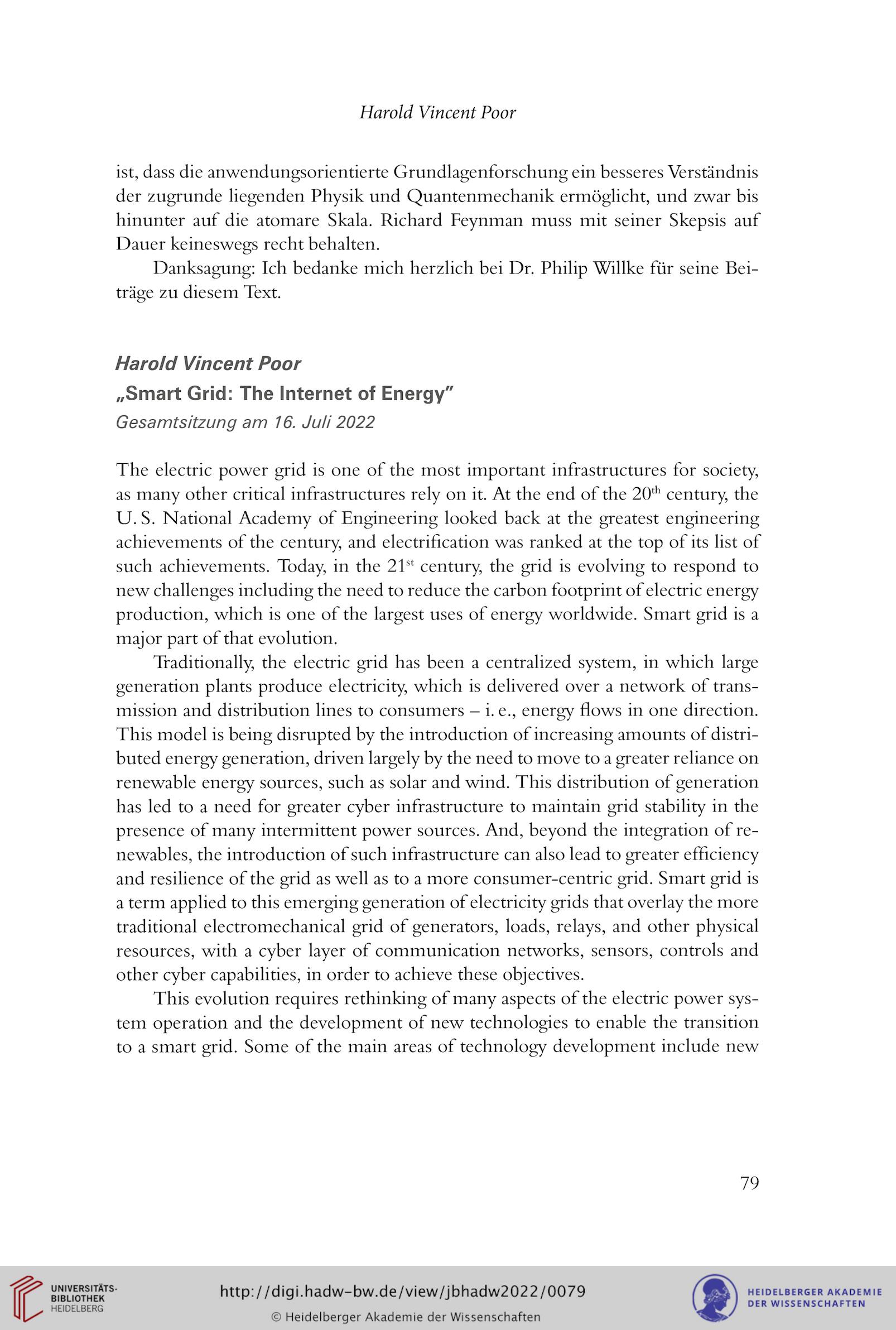Heidelberger Akademie der Wissenschaften [Editor]
Jahrbuch ... / Heidelberger Akademie der Wissenschaften: Jahrbuch 2022
— 2023
Cite this page
Please cite this page by using the following URL/DOI:
https://doi.org/10.11588/diglit.67410#0079
DOI chapter:
A. Das akademische Jahr 2022
DOI chapter:II. Wissenschaftliche Vorträge
DOI article:Wernsdorfer, Wolfgang: Quantencomputer in der Gegenwart: der aktuelle Stand der Forschung
DOI article:Poor, H. Vincent: Smart grid: the internet of energy
DOI Page / Citation link:https://doi.org/10.11588/diglit.67410#0079
- Schmutztitel
- Titelblatt
- 5-10 Inhaltsverzeichnis
-
11-172
A. Das akademische Jahr 2022
-
11-37
I. Jahresfeier am 21. Mai 2022
- 11-12 Begrüßung durch den Präsidenten Bernd Schneidmüller
- 13-15 Grußwort des Präsidenten der Akademie von Athen Antonios Rengakos
- 16-22 Verantwortung und das Prinzip von Wissenschaft. Bericht des Präsidenten
- 23-24 Kurzbericht des Sprechers des WIN-Kollegs Martin Fungisai Gerchen
- 36-37 Verleihung der Preise
-
38-101
II. Wissenschaftliche Vorträge
-
102-172
III. Veranstaltungen
- 102-106 Academy for Future – Klimakrise: Warum müssen wir jetzt handeln? Öffentliche Veranstaltungsreihe der Arbeitsgruppe „Klimakrise“
- 106-108 Akademievorträge. Gemeinsame Vortragsreihe der Heidelberger Akademie der Wissenschaften mit der Württembergischen Landesbibliothek
-
109-121
Mitarbeitervortragsreihe „Wir forschen. Für Sie“
- 126 Internationale Kooperation mit der Estnischen Akademie der Wissenschaften
-
127
Verleihung des Reuchlinpreises 2022 an die Islamwissenschaftlerin Katajun Amirpur
- 147-151 Sebestyén, Ágnes; Weber, Andreas: Netzwerktreffen mit Postdoktorandinnen und Postdoktoranden des Eliteprogramms der Baden-Württemberg Stiftung. 14. und 15. November 2022
-
151-170
Verleihung des Karl-Jaspers-Preises 2022 an den Philosophen Volker Gerhardt
-
11-37
I. Jahresfeier am 21. Mai 2022
- 173-241 B. Die Mitglieder
-
243-356
C. Die Forschungsvorhaben
- 243-244 I. Forschungsvorhaben und Arbeitsstellenleitung
-
245-347
II. Tätigkeitsberichte
- 245-249 1. Deutsche Inschriften des Mittelalters
- 249-255 2. Deutsches Rechtswörterbuch
- 255-262 3. Goethe-Wörterbuch (Tübingen)
- 262-265 4. Melanchthon-Briefwechsel
- 265-270 5. Edition literarischer Keilschrifttexte aus Assur
- 270-278 6. Buddhistische Steinschriften in Nordchina
- 278-293 7. The Role of Culture in Early Expansions of Humans (Frankfurt und Tübingen)
- 294-299 8. Nietzsche-Kommentar (Freiburg)
- 300-309 9. Klöster im Hochmittelalter
- 309-312 10. Der Tempel als Kanon der religiösen Literatur Ägyptens (Tübingen)
- 313-316 11. Kommentierung der Fragmente der griechischen Komödie (Freiburg im Breisgau)
- 317-320 12. Karl-Jaspers-Gesamtausgabe (KJG)
- 320-326 13. Historisch-philologischer Kommentar zur Weltchronik des Johannes Malalas
- 326-333 14. Religions- und rechtsgeschichtliche Quellen des vormodernen Nepal
- 333-339 15. Theologenbriefwechsel im Südwesten des Reichs in der Frühen Neuzeit (1550–1620)
- 339-345 16. Hinduistische Tempellegenden in Südindien
- 345-347 17. Wissensnetze in der mittelalterlichen Romania (ALMA)
- 348-354 III. Drittmittelgeförderte Projekte
- 355-356 IV. Kooperationsprojekte
-
357-434
D. Förderung des wissenschaftlichen Nachwuchses
- 357-372 I. Preise der Akademie
- 373 II. Die Junge Akademie | HAdW
- 374-376 III. Das WIN-Kolleg der Jungen Akademie | HAdW
- 414 IV. Das Akademie-Kolleg der Jungen Akademie | HAdW
-
435-455
E. Anhang
-
435-439
I. Organe, Mitglieder, Institutionen
- 435-436 Vorstand und Geschäftsstelle
- 436 Personalrat / Ombudsperson „Gute wissenschaftliche Praxis“ / Ombudsperson „Partnerschaftliches Miteinander“ / Union der deutschen Akademien der Wissenschaften
- 437 Vertreter der Akademie in Kommissionen der Union / Vertreter der Akademie in anderen wissenschaftlichen Institutionen
- 438 Verein zur Förderung der Heidelberger Akademie der Wissenschaften e.V.
- 439 Tabula Mortuorum 2022
- 440 II. Gesamthaushalt 2022 der Heidelberger Akademie der Wissenschaften
- 441-446 III. Publikationen
-
435-439
I. Organe, Mitglieder, Institutionen
- 447-455 Personenregister
Harold Vincent Poor
ist, dass die anwendungsorientierte Grundlagenforschung ein besseres Verständnis
der zugrunde liegenden Physik und Quantenmechanik ermöglicht, und zwar bis
hinunter auf die atomare Skala. Richard Feynman muss mit seiner Skepsis auf
Dauer keineswegs recht behalten.
Danksagung: Ich bedanke mich herzlich bei Dr. Philip Willke für seine Bei-
träge zu diesem Text.
Harold Vincent Poor
„Smart Grid: The Internet of Energy"
Gesamtsitzung am 16. Juli 2022
The electric power grid is one of the most important infrastructures for society,
as many other critical infrastructures rely on it. At the end of the 20th Century, the
U. S. National Academy of Engineering looked back at the greatest engineering
achievements of the Century, and electrification was ranked at the top of its list of
such achievements. Today, in the 21st Century, the grid is evolving to respond to
new challenges including the need to reduce the earbon footprint of electric energy
production, which is one of the largest uses of energy worldwide. Smart grid is a
major part of that evolution.
Traditionally, the electric grid has been a centralized System, in which large
generation plants produce electricity, which is delivered over a network of trans-
mission and distribution lines to consumers - i. e., energy flows in one direction.
This model is being disrupted by the introduction of increasing amounts of distri-
buted energy generation, driven largely by the need to move to a greater reliance on
renewable energy sources, such as solar and wind. This distribution of generation
has led to a need for greater cyber infrastructure to maintain grid stability in the
presence of many intermittent power sources. And, beyond the Integration of re-
newables, the introduction of such infrastructure can also lead to greater efficiency
and resilience ofthc grid as well as to a more consumer-centric grid. Smart grid is
a term applied to this emerging generation of electricity grids that overlay the more
traditional electromechanical grid of generators, loads, relays, and other physical
resources, with a cyber layer of communication networks, sensors, Controls and
other cyber capabilities, in order to achieve these objectives.
This evolution requires rethinking of many aspects of the electric power Sys-
tem Operation and the development of new technologies to enable the transition
to a smart grid. Some of the main areas of technology development include new
79
ist, dass die anwendungsorientierte Grundlagenforschung ein besseres Verständnis
der zugrunde liegenden Physik und Quantenmechanik ermöglicht, und zwar bis
hinunter auf die atomare Skala. Richard Feynman muss mit seiner Skepsis auf
Dauer keineswegs recht behalten.
Danksagung: Ich bedanke mich herzlich bei Dr. Philip Willke für seine Bei-
träge zu diesem Text.
Harold Vincent Poor
„Smart Grid: The Internet of Energy"
Gesamtsitzung am 16. Juli 2022
The electric power grid is one of the most important infrastructures for society,
as many other critical infrastructures rely on it. At the end of the 20th Century, the
U. S. National Academy of Engineering looked back at the greatest engineering
achievements of the Century, and electrification was ranked at the top of its list of
such achievements. Today, in the 21st Century, the grid is evolving to respond to
new challenges including the need to reduce the earbon footprint of electric energy
production, which is one of the largest uses of energy worldwide. Smart grid is a
major part of that evolution.
Traditionally, the electric grid has been a centralized System, in which large
generation plants produce electricity, which is delivered over a network of trans-
mission and distribution lines to consumers - i. e., energy flows in one direction.
This model is being disrupted by the introduction of increasing amounts of distri-
buted energy generation, driven largely by the need to move to a greater reliance on
renewable energy sources, such as solar and wind. This distribution of generation
has led to a need for greater cyber infrastructure to maintain grid stability in the
presence of many intermittent power sources. And, beyond the Integration of re-
newables, the introduction of such infrastructure can also lead to greater efficiency
and resilience ofthc grid as well as to a more consumer-centric grid. Smart grid is
a term applied to this emerging generation of electricity grids that overlay the more
traditional electromechanical grid of generators, loads, relays, and other physical
resources, with a cyber layer of communication networks, sensors, Controls and
other cyber capabilities, in order to achieve these objectives.
This evolution requires rethinking of many aspects of the electric power Sys-
tem Operation and the development of new technologies to enable the transition
to a smart grid. Some of the main areas of technology development include new
79




